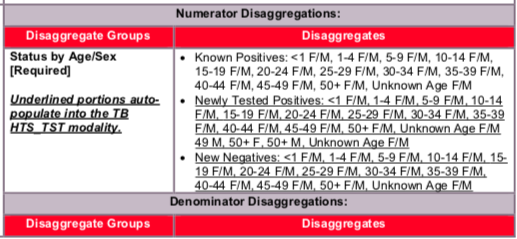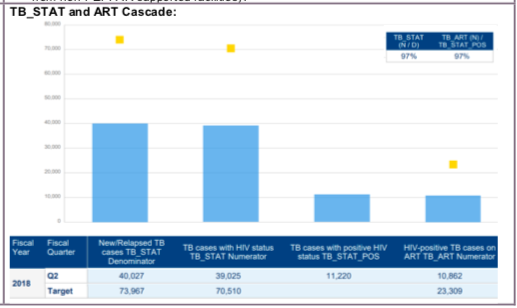(TB_STAT) (including TB_STAT_POS) Percentage of new and relapse TB cases with documented HIV status
Export Indicator
This indicator measures the performance of the TB program in ensuring that TB cases know their HIV status.
Number of new and relapsed TB cases with documented HIV status, during the reporting period
Total number of new and relapsed TB cases, during the reporting period
How to calculate annual total: Sum results across quarters for both the numerator and denominator.
How to collect:
The numerator and denominator can be obtained from basic management unit TB registers as well as additional data collection sources (i.e., HIV testing registers) that may contain relevant information (i.e., HIV test results, enrollment in HIV care programs). Programs should modify the register as needed to easily capture this information (<1 F, <1 M, 1-4 F, 1-4 M, 5-9 F, 5-9 M, 10-14 F, 10-14 M, 15-19 F, 15-19 M, 20-24 F, 20-24 M, 25-29 F, 25-29 M, 30-34 F, 30-34 M, 35-39 F, 35-39 M, 40-44 F, 40-44 M, 45-49 F, 45-49 M, 50+ F, 50+ M, Unknown age F, Unknown age M) and (Known HIV-positive at service entry).
The data source is the TB register. There is a risk of double counting as TB patients could be tested multiple times during their TB treatment, therefore partners should ensure a data collection and reporting system is in place to minimize double counting. There is also a risk of undercounting if those patients who already knew their HIV status prior to attending TB clinic are not documented, therefore the TB register at a minimum should document “Known HIV-positive at service entry; Newly tested HIV-positive; Tested HIV negative.”
Reporting level: Facility
How to review for data quality:
Only one disaggregation type is used for age and gender (fine age and gender disaggregations)
- Denominator ≥ Numerator
- Numerator ≥ subtotal of each of the disaggregations
- Denominator ≥ subtotal of each of the disaggregations
Reporting frequency: Quarterly


The numerator can be generated by counting the number of new and relapsed TB cases with documented HIV test results during the reporting period.
The denominator can be generated by counting the number of new and relapse TB cases during the reporting period.
Indicator changes (MER 2.0 v2.3 to v2.4): None
PEPFAR Support definition:
Standard definition of DSD and TA-SDI used.
Provision of key staff or commodities for TB cases receiving HIV-related services includes: funding of test kits, ARVs, ARTs, and lab commodities or funding of salaries or provision of Health Care Workers for TB/HIV-related services. Staff responsible for maintaining patient records are included in this category however staff responsible for fulfilling reporting and routine M&E requirements are not included.
Ongoing support for TB cases receiving HIV-related services includes: training of TB/HIV service providers, clinical mentoring and supportive supervision of staff at TB/HIV sites, infrastructure/renovation of facilities, support of TB/HIV service data collection, reporting, data quality, QI/QA of TB/HIV services support, ARV consumption forecasting and supply management, support of lab clinical monitoring of patients, supporting patient follow up/retention, support of other TB/HIV programs.
Guiding narrative questions:
- If coverage for this indicator is less than 90%, please explain why.
- Please describe how the denominator was determined.
- Describe the sources for the data that you are reporting (i.e., are the data from just PEPFAR-supported facilities or do the data reflect national-level data, including those from non-PEPFAR supported facilities)?
